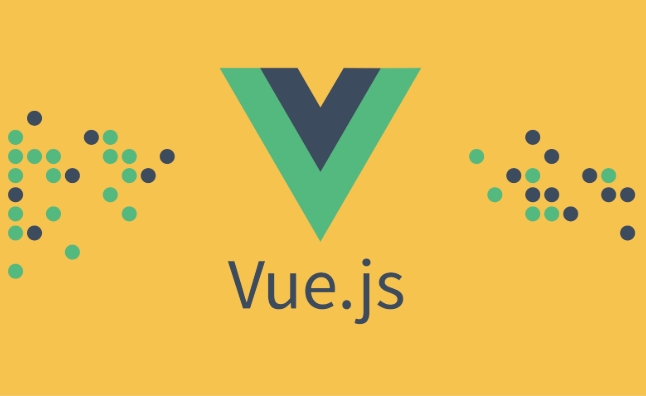The methods of dynamically adding or deleting form fields in Vue are as follows: 1. Use an array to store field data, and automatically update the DOM with Vue's responsive system; 2. Create a method to add fields, add new items to the array by push(), and set an upper limit; 3. Create a method to delete fields, use splice() to safely remove fields of the specified index, and set a minimum retention number; 4. For complex form data, you can use an object array to store multiple field types and their values to achieve more flexible input management.

In Vue, dynamically adding or removing form fields is a common requirement when building flexible forms—like allowing users to input multiple email addresses, phone numbers, or addresses. The key is to manage the form data with Vue's reactivity system and use v-for to render the fields dynamically.

Let's break it down into practical steps.
Using an Array to Store Dynamic Fields
The foundation of dynamic fields in Vue is using an array to store the values. Vue's reactivity works well with array mutations, so when you add or remove items from the array, the DOM updates automatically.

For example:
data() {
return {
emails: ['']
}
}Then in your template:

<div v-for="(email, index) in emails" :key="index"> <input v-model="email" type="email" /> <button @click="removeEmail(index)">Remove</button> </div> <button @click="addEmail">Add Email</button>
This sets up a loop that renders one input per email in the array.
Adding a New Field with a Button
To add a new field, create a method that pushes an empty string (or default value) into the array:
methods: {
addEmail() {
this.emails.push('')
}
}Now, when the user clicks "Add Email", a new input field appears.
You can also set a limit to prevent too many fields from being added:
methods: {
addEmail() {
if (this.emails.length < 5) {
this.emails.push('')
}
}
}This avoids overwhelming the user with too many inputs.
Removing a Field Safely
Removing a field is just as important. Use splice() to remove an item from the array by index:
methods: {
removeEmail(index) {
this.emails.splice(index, 1)
}
}A few things to note:
- Always use
splice()instead ofdeletebecause it modifies the array correctly and Vue will react to it. - If there's only one field left, you might want to leave it empty instead of removing it:
removeEmail(index) {
if (this.emails.length > 1) {
this.emails.splice(index, 1)
}
}This prevents the user from accidentally deleting all fields.
Handling Complex Form Data (Optional)
If your form fields are more complex than just strings—like having multiple inputs per item—you can store objects in the array instead:
data() {
return {
contacts: [
{ type: 'email', value: '' }
]
}
}Then in the template:
<div v-for="(contact, index) in contacts" :key="index">
<select v-model="contact.type">
<option value="email">Email</option>
<option value="phone">Phone</option>
</select>
<input v-model="contact.value" />
<button @click="removeContact(index)">Remove</button>
</div>
<button @click="addContact">Add Contact</button>And the methods:
methods: {
addContact() {
this.contacts.push({ type: 'email', value: '' })
},
removeContact(index) {
if (this.contacts.length > 1) {
this.contacts.splice(index, 1)
}
}
}This gives you more flexibility for handling different types of inputs.
So, dynamically managing form fields in Vue is basically about updating an array and letting Vue re-render based on that. It's not complicated once you get the pattern—just manage the array, bind the inputs with v-model , and use v-for to loop through them.
The above is the detailed content of How to dynamically add or remove form fields in Vue?. For more information, please follow other related articles on the PHP Chinese website!

Hot AI Tools

Undress AI Tool
Undress images for free

Undresser.AI Undress
AI-powered app for creating realistic nude photos

AI Clothes Remover
Online AI tool for removing clothes from photos.

Clothoff.io
AI clothes remover

Video Face Swap
Swap faces in any video effortlessly with our completely free AI face swap tool!

Hot Article

Hot Tools

Notepad++7.3.1
Easy-to-use and free code editor

SublimeText3 Chinese version
Chinese version, very easy to use

Zend Studio 13.0.1
Powerful PHP integrated development environment

Dreamweaver CS6
Visual web development tools

SublimeText3 Mac version
God-level code editing software (SublimeText3)

Hot Topics
 Can computed properties accept arguments?
Jul 02, 2025 am 12:58 AM
Can computed properties accept arguments?
Jul 02, 2025 am 12:58 AM
The computed properties of Vue.js cannot directly accept parameters, which is determined by its design characteristics, but can be implemented indirectly through the computed properties of methods or return functions. 1. Methods: Parameters can be passed and used in templates or listeners, such as formatName('John','Doe'); 2. Encapsulate the computed attributes into the form of a return function: such as formatName returns a function that accepts parameters, and call formatName()('Jane','Smith') in the template. The method of use is usually recommended because it is clearer and easier to maintain, and the way of returning functions is suitable for special scenarios where internal state and external values ??are required.
 What is headless UI in Vue?
Jul 08, 2025 am 01:38 AM
What is headless UI in Vue?
Jul 08, 2025 am 01:38 AM
HeadlessUIinVue refers to a library of UI components that provide no preset styles and only contains core logic and behavior. Its features include: 1. No style restrictions, developers can customize the design; 2. Focus on barrier-free and interactive logic, such as keyboard navigation, state management, etc.; 3. Support Vue framework integration, exposing the control interface through combinable functions or components. Reasons for use include: maintaining design consistency, built-in accessibility, strong component reusability, and lightweight library size. In practical applications, developers need to write HTML and CSS themselves. For example, when building a drop-down menu, the library handles state and interaction, while developers decide on visual presentation. Mainstream libraries include HeadlessUI and RadixVue for TailwindLabs, suitable for
 How to watch nested properties in Vue 3?
Jul 07, 2025 am 12:51 AM
How to watch nested properties in Vue 3?
Jul 07, 2025 am 12:51 AM
In Vue3, there are three ways to monitor nested properties using the watch function: 1. Use the getter function to accurately monitor specific nested paths, such as watch(()=>someObject.nested.property,callback); 2. Add the {deep:true} option to deeply monitor changes within the entire object, which is suitable for situations where the structure is complex and does not care about which property changes; 3. Return an array in the getter to listen to multiple nested values ??at the same time, which can be used in combination with deep:true; in addition, if ref is used, the nested properties in its .value need to be tracked through getter.
 How to create a Vue 3 project with Vite?
Jul 05, 2025 am 01:39 AM
How to create a Vue 3 project with Vite?
Jul 05, 2025 am 01:39 AM
It is recommended to use Vite to create Vue3 projects because it uses the browser's native ES module support and has a fast startup speed in development mode. 1. Make sure to install Node.js (16.x or higher) and npm/yarn/pnpm; 2. Run npmcreatevite@latestmy-vue-app--templatevue initialization project; 3. Follow the prompts to select TypeScript, VueRouter and other configurations; 4. Execute cdmy-vue-app and npminstall installation dependencies; 5. Use npmrundev to start the development server. Optional configurations include automatic browser opening, proxy settings, alias paths, and packaging optimizations. Recommended insurance
 How to build a component library with Vue?
Jul 10, 2025 pm 12:14 PM
How to build a component library with Vue?
Jul 10, 2025 pm 12:14 PM
Building a Vue component library requires designing the structure around the business scenario and following the complete process of development, testing and release. 1. The structural design should be classified according to functional modules, including basic components, layout components and business components; 2. Use SCSS or CSS variables to unify the theme and style; 3. Unify the naming specifications and introduce ESLint and Prettier to ensure the consistent code style; 4. Display the usage of components on the supporting document site; 5. Use Vite and other tools to package as NPM packages and configure rollupOptions; 6. Follow the semver specification to manage versions and changelogs when publishing.
 Key differences between Vue 2 and Vue 3?
Jul 09, 2025 am 01:29 AM
Key differences between Vue 2 and Vue 3?
Jul 09, 2025 am 01:29 AM
Vue3 has improved in many key aspects compared to Vue2. 1.Composition API provides a more flexible logical organization method, allowing centralized management of related logic, while still supporting Vue2's Options API; 2. Better performance and smaller package size, the core library is reduced by about 30%, the rendering speed is faster and supports better tree shake optimization; 3. The responsive system uses ES6Proxy to solve the problem of unable to automatically track attribute addition and deletion in Vue2, making the responsive mechanism more natural and consistent; 4. Built-in better support for TypeScript, support multiple node fragments and custom renderer API, improving flexibility and future adaptability. Overall, Vue3 is a smooth upgrade to Vue2,
 How to define routes in vue router?
Jul 05, 2025 am 12:58 AM
How to define routes in vue router?
Jul 05, 2025 am 12:58 AM
Defining routes in Vue projects requires understanding the structure and configuration. The steps are as follows: 1. Install and introduce vue-router, create a routing instance, and pass in a routes array containing path and component; 2. Use dynamic routing matching such as /user/:id to obtain parameters; 3. Use children attribute to implement nested routes; 4. Name the routes with the name attribute for jumping; 5. Use redirect for path redirect. After mastering these core points, you can configure routing efficiently.
 What are the potential drawbacks of using mixins?
Jul 01, 2025 am 12:01 AM
What are the potential drawbacks of using mixins?
Jul 01, 2025 am 12:01 AM
Although Mixins is practical in front-end development, it needs to be used with caution. The problems include: 1. Over-abstract causes maintenance difficulties, nested hierarchy depth is difficult to track, it is recommended to control complexity and add comments; 2. Generate redundant code, frequent calls make CSS inflated, and it is recommended to use class or placeholder selector instead; 3. Reduced readability affects collaboration, inconsistent naming increases communication costs, specifications should be formulated and documented; 4. Debugging is more troublesome, the style source is not easy to find, and it depends on sourcemap assistance. Only by using it rationally can you truly improve efficiency.






